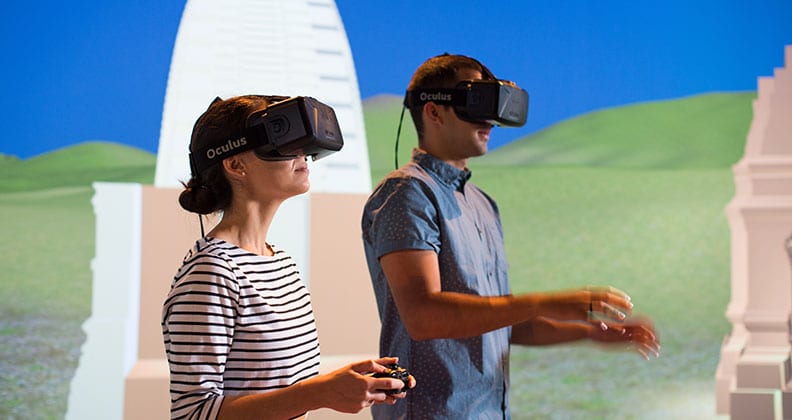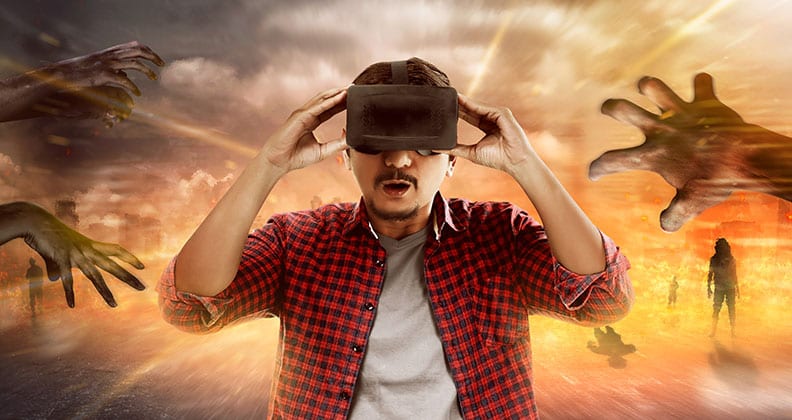The trailer for Steven Spielberg’s Ready Player One has thrown the possibilities of virtual reality technologies into the limelight. But like the eerie conjectures of The Matrix before it, the narrative also serves as a reminder of how virtual reality is becoming increasingly indistinguishable from the real, with virtual reality and augmented reality technologies being more sophisticated and popular than ever before. How concerned should we be?
“I am worried about addiction and I do believe there is the possibility that we could forget our social conventions,” states Professor Erik Champion from Curtin University’s School of Media, Culture and Creative Arts.
“For example, ten years ago at a video game conference, I put up my hand and asked: ‘Should we ever worry if games become too engaging?’ Nobody wanted to answer me because they were all game developers.”
Champion, a researcher who has spent the past two decades working in the varied areas of architecture, gaming and virtual reality, believes the way forward is to provide virtual reality experiences that promote interaction and education over social withdrawal.
As the United Nations Educational, Scientific and Cultural Organisation Professional Chair in Cultural Heritage & Visualisation, he is developing a repository of virtual reality models of heritage sites in Australia and overseas and importing these models into a virtual reality game that a museum, gallery or library can use as an interactive educational experience.
“My personal interest is to apply the constraints of virtual reality to help people understand how other cultures think or act differently to their own,” says Champion, who is supervising PhD students in areas such as heritage trails, virtual recreations of contested political spaces and panoramic documentaries of live action role-playing.
“We would like to have something similar to, say, the 3D online models and editor provided by the Smithsonian Institution or repositories like 3D-Icons Ireland. Not only have they digitised most of their models – you can download and edit many of them. We also intend to organise workshops to ‘teach the teachers’ how to use them.
“I want to encourage people to meet and talk because for me putting people alone into these little head-mounted displays isn’t fully leveraging the potential of this technology.”

Students taking part in a virtual heritage simulation at the Curtin HIVE (Hub for Immersive Visualisation and eResearch).
Meanwhile, Dr Artur Lugmayr believes any reluctance to embrace new technology is simply human nature.
“When the first films were shown and a train rushed towards the camera, everyone ran out of the cinema,” he explains, referring to the urban legend surrounding the 1885 French film, Arrival of a Train at La Ciotat, before adding rhetorically, “I think in the future, there will be a lot of discussion about ethics, but for now the question is: ‘Can we stop it or not?’”
Lugmayr even implies that the potential advantages of virtual reality technologies far exceed the disadvantages. Paraphrasing from American philosopher Marshall McLuhan’s 1964 pioneering book on media, Understanding Media: The Extensions of Man, Lugmayr strongly believes in the saying that ‘each new technology is an extension of your body’.
“If I have a lamp, I can read in the night. If I have a bicycle, I can get around faster. And if I have a virtual environment, I will have even more capabilities,” he reasons.
“Depersonalisation may even be an advantage for people who are physically disabled because they can navigate through a virtual environment without limitation. But maybe I have too much of a technology-driven viewpoint. I think it’s just a natural trend.”
Lugmayr believes that sometimes it’s essential to have simulations within a virtually created world. As a tutor, he has encouraged students to develop virtual reality applications across business, health, humanities and science, while he has researched how these technologies could be used to help interpret big data (large data sets relating to human behaviour).
“Many think that big data is simply about processing huge amounts of data. But we only need ‘spotlight data’ to help us solve our problems and the appropriate visualisation to help us understand the knowledge and information contained within the data,” he explains.
Professor Artur Lugmayr has recently developed a web-based user experience analysis platform to capture and interpret biofeedback data to gain insights about a person’s emotional state.
Looking to the future of the virtual
It’s been a long time coming, but the affordability of the technology has finally allowed AR and VR to make the leap from tech curiosity to mainstream consumer product. Sony has now sold more than one million PlayStation VR headsets worldwide, while last year’s smash-hit augmented reality game, Pokémon GO, has had more than 750 million global downloads.
There’s also no longer a technological or financial barrier to prospective developers getting in on the action. Apple’s recently announced ARKit will give developers the opportunity to create augmented reality experiences on their iPhone and iPad for free, and Microsoft’s Windows Mixed Reality kit has further opened the playing field.
As the popularity and sophistication of this type of technology increases, so too will the debate over its societal impact, but instead of worrying about hypothetical dystopian futures, we could iron out ethical guidelines for using these technologies and focus on the possibilities – using them as sources of knowledge, tools for research or platforms to connect people.
What do you think? If you share some of the excitement (or concerns) about virtual reality and augmented reality technologies, leave a comment below!



